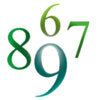Skip over navigation
Is there a repeating pattern in the number you've created? You could look to see if the first digit appears again anywhere else in the number, for example.
You could also look for symmetrical patterns of numbers.
You could carry on and generate more digits in the number to check if the pattern continues.
You might like to use a calculator!



Or search by topic
Number and algebra
Geometry and measure
Probability and statistics
Working mathematically
Advanced mathematics
For younger learners
Mobile Numbers
Age 5 to 11
Challenge Level 





- Problem
- Getting Started
- Student Solutions
- Teachers' Resources
Is there a repeating pattern in the number you've created? You could look to see if the first digit appears again anywhere else in the number, for example.
You could also look for symmetrical patterns of numbers.
You could carry on and generate more digits in the number to check if the pattern continues.
You might like to use a calculator!
You may also like
Prompt Cards
These two group activities use mathematical reasoning - one is numerical, one geometric.
Consecutive Numbers
An investigation involving adding and subtracting sets of consecutive numbers. Lots to find out, lots to explore.
Exploring Wild & Wonderful Number Patterns
EWWNP means Exploring Wild and Wonderful Number Patterns Created by Yourself! Investigate what happens if we create number patterns using some simple rules.

